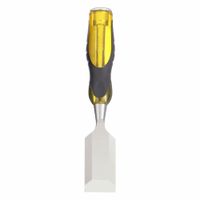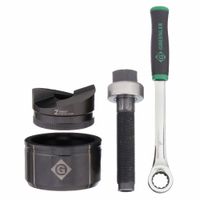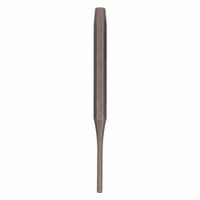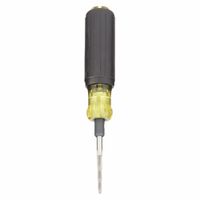Call +(254) 703 030 000 / 751 483 999 / 721 704 777
- Home
- Tools
- Hand Tools
- Punching Tools Chisels
.....Read More
Frequently Asked Questions
What are the different types of punches and chisels?
Punches and chisels are essential hand tools used in metalworking, woodworking, and masonry. Here are the different types:
**Punches:**
1. **Center Punch:** Used to mark the center of a point, typically for drilling. It creates a dimple to guide the drill bit.
2. **Prick Punch:** Similar to a center punch but with a sharper point, used for marking precise locations.
3. **Pin Punch:** Designed to drive pins out of holes without damaging the surrounding material.
4. **Drift Punch:** Used to align holes by inserting and adjusting the position of the workpiece.
5. **Transfer Punch:** Used to transfer the location of holes through a template onto a workpiece.
6. **Letter and Number Punches:** Used to imprint letters and numbers onto materials for identification.
7. **Solid Punch:** Used to drive objects such as nails or pins into a surface.
**Chisels:**
1. **Cold Chisel:** Made of hardened steel, used for cutting metal that is not heated.
2. **Wood Chisel:** Used for carving or cutting wood, available in various shapes like bevel edge, firmer, and paring chisels.
3. **Masonry Chisel:** Designed for cutting or shaping stone, brick, or concrete.
4. **Cape Chisel:** Features a narrow cutting edge, used for cutting grooves or slots in metal.
5. **Round Nose Chisel:** Used for cutting semicircular grooves.
6. **Diamond Point Chisel:** Used for cutting V-shaped grooves.
7. **Flat Chisel:** Used for cutting and shaping metal, with a wide, flat edge.
8. **Corner Chisel:** Used for cutting sharp corners in wood or metal.
Each type of punch and chisel is designed for specific tasks, ensuring precision and efficiency in various applications.
How do you properly use a punch or chisel?
To properly use a punch or chisel, follow these steps:
1. **Select the Right Tool**: Choose the appropriate punch or chisel for the task. For punches, consider the type (center, pin, or drift) and size. For chisels, select between cold chisels for metal or wood chisels for woodworking.
2. **Safety Gear**: Wear safety goggles to protect your eyes from flying debris. Use gloves to protect your hands, if necessary.
3. **Secure the Workpiece**: Ensure the material you are working on is securely clamped or held in place to prevent movement during use.
4. **Positioning**: For punches, position the tip on the exact spot you need to mark or drive. For chisels, angle the blade correctly for the desired cut, typically at a 30 to 45-degree angle for wood chisels.
5. **Grip**: Hold the punch or chisel firmly but not too tightly. For punches, grip the handle with your dominant hand. For chisels, use one hand to guide the blade and the other to hold the handle.
6. **Striking**: Use a hammer or mallet appropriate for the tool. For punches, strike the head with controlled, firm blows. For chisels, use a mallet for wood chisels and a hammer for cold chisels, applying consistent force.
7. **Control**: Maintain control over the tool to ensure precision. For chisels, apply steady pressure and guide the tool along the desired path.
8. **Maintenance**: Keep tools sharp and clean. Regularly sharpen chisels and ensure punches are not mushroomed or damaged.
9. **Storage**: Store tools in a dry place to prevent rust and damage.
By following these steps, you can effectively and safely use punches and chisels for various tasks.
What materials are punches and chisels made from?
Punches and chisels are typically made from high-carbon steel or alloy steel. High-carbon steel is favored for its hardness and ability to maintain a sharp edge, which is crucial for cutting and shaping materials. This type of steel contains a higher percentage of carbon, usually between 0.6% and 1.5%, which enhances its strength and wear resistance.
Alloy steel, on the other hand, includes additional elements such as chromium, vanadium, or molybdenum, which improve the tool's toughness, durability, and resistance to impact and abrasion. These elements also help in maintaining the tool's integrity under high-stress conditions, making alloy steel a popular choice for heavy-duty applications.
Some punches and chisels may also be made from tool steel, a variety of carbon and alloy steels that are particularly well-suited for making tools. Tool steel is known for its hardness, resistance to deformation, and ability to hold a cutting edge at elevated temperatures.
In addition to the base material, punches and chisels often undergo heat treatment processes such as quenching and tempering. Quenching involves heating the steel to a high temperature and then rapidly cooling it, which increases hardness. Tempering follows quenching and involves reheating the steel to a lower temperature, then cooling it again to reduce brittleness while maintaining hardness.
For specialized applications, punches and chisels might be coated with materials like titanium nitride or black oxide to further enhance their wear resistance and reduce friction. These coatings can extend the tool's lifespan and improve performance in demanding environments.
How do you maintain and sharpen punches and chisels?
To maintain and sharpen punches and chisels, follow these steps:
1. **Inspection**: Regularly inspect the tools for any signs of wear, such as mushroomed heads, chips, or dull edges. This helps in identifying when maintenance is needed.
2. **Safety Precautions**: Wear safety goggles and gloves to protect against metal shards and sharp edges during the sharpening process.
3. **Mushroom Head Removal**: If the head of a chisel or punch has mushroomed, use a bench grinder to remove the excess metal. Hold the tool at a slight angle and rotate it to ensure even grinding.
4. **Sharpening**: For chisels, use a sharpening stone or a bench grinder. Hold the chisel at the correct bevel angle (usually 25-30 degrees) and move it back and forth across the stone or grinder. For punches, use a file or grinder to restore the tip to a sharp point.
5. **Cooling**: During grinding, dip the tool in water frequently to prevent overheating, which can damage the metal's temper.
6. **Honing**: After grinding, hone the edge with a finer sharpening stone or honing tool to achieve a razor-sharp finish. This step is crucial for chisels to ensure a smooth cut.
7. **Lubrication**: Apply a light coat of oil to the tools after sharpening to prevent rust and corrosion.
8. **Storage**: Store punches and chisels in a dry place, ideally in a tool roll or box, to protect the edges and prevent damage.
9. **Regular Maintenance**: Establish a routine for checking and maintaining your tools to ensure they remain in optimal condition for use.
What safety precautions should be taken when using punches and chisels?
When using punches and chisels, several safety precautions are essential to prevent accidents and injuries:
1. **Personal Protective Equipment (PPE):** Always wear safety goggles or a face shield to protect your eyes from flying debris. Use gloves to protect your hands from sharp edges and vibrations, and wear steel-toed boots to safeguard your feet.
2. **Tool Inspection:** Before use, inspect punches and chisels for any signs of damage, such as cracks, chips, or mushroomed heads. Damaged tools should be repaired or replaced to prevent breakage during use.
3. **Proper Tool Selection:** Use the correct type and size of punch or chisel for the specific task. Using the wrong tool can lead to tool damage or personal injury.
4. **Secure Workpiece:** Ensure the workpiece is securely clamped or held in place to prevent movement during operation, which can lead to loss of control and injury.
5. **Correct Technique:** Hold the tool firmly and strike it with a hammer that is appropriate in size and weight. Ensure your hands and body are positioned safely away from the striking area.
6. **Controlled Environment:** Work in a well-lit area to maintain visibility and reduce the risk of accidents. Keep the workspace clean and free of clutter to avoid tripping hazards.
7. **Avoid Distractions:** Stay focused on the task at hand. Distractions can lead to mistakes and accidents.
8. **Regular Maintenance:** Keep tools sharp and well-maintained. Dull tools require more force and can slip, increasing the risk of injury.
9. **Training:** Ensure that you are properly trained in the use of punches and chisels. Understanding the correct techniques and safety measures is crucial for safe operation.
10. **Storage:** Store tools properly when not in use to prevent damage and ensure they are in good condition for future use.
What is the difference between a punch and a chisel?
A punch and a chisel are both hand tools used in metalworking and woodworking, but they serve different purposes and have distinct designs.
A punch is a tool used to indent or mark materials. It typically has a pointed or blunt end and is struck with a hammer to create an impression or hole in the material. Punches come in various types, such as center punches, which are used to mark the center of a point for drilling, and pin punches, which are used to drive pins out of holes. The primary function of a punch is to guide drills or to mark specific points on a surface.
A chisel, on the other hand, is a tool used for cutting or carving materials. It has a sharp, beveled edge and is designed to remove material by slicing or shaving it away. Chisels are used in woodworking, metalworking, and masonry. They come in various shapes and sizes, such as flat chisels, which are used for general cutting, and gouges, which have a curved blade for carving. The main purpose of a chisel is to shape or refine the material by removing excess parts.
In summary, the key difference lies in their functions: punches are primarily used for marking or creating indentations, while chisels are used for cutting and shaping materials. Their designs reflect these purposes, with punches having pointed or blunt ends and chisels having sharp, beveled edges.
How do you choose the right punch or chisel for a specific task?
Choosing the right punch or chisel for a specific task involves considering several factors to ensure efficiency and precision:
1. **Material Type**: Determine the material you are working with. Softer materials like wood require different tools than harder materials like metal or stone. For wood, use wood chisels; for metal, use cold chisels; and for stone, use stone chisels.
2. **Task Specificity**: Identify the specific task. For marking, use center punches; for driving pins, use pin punches; for cutting, use chisels. Each tool is designed for a specific function.
3. **Size and Shape**: Choose the appropriate size and shape. The diameter and length of a punch or chisel should match the task requirements. For example, a larger punch is needed for larger holes, while a smaller one is suitable for precision work.
4. **Tool Material**: Consider the tool's material. High-carbon steel is common for durability and strength. For heavy-duty tasks, tools with hardened tips are preferable.
5. **Handle Design**: Evaluate the handle design for comfort and control. Ergonomic handles reduce fatigue and improve precision. For chisels, a good grip is essential for safety and effectiveness.
6. **Edge and Tip**: Ensure the edge or tip is sharp and well-maintained. A dull tool can damage the workpiece and reduce efficiency. Regular sharpening and maintenance are crucial.
7. **Safety Features**: Look for safety features like hand guards or anti-slip grips to prevent accidents during use.
8. **Brand and Quality**: Opt for reputable brands known for quality and durability. Investing in high-quality tools can save time and money in the long run.
By considering these factors, you can select the right punch or chisel that aligns with your specific task requirements, ensuring optimal performance and safety.






